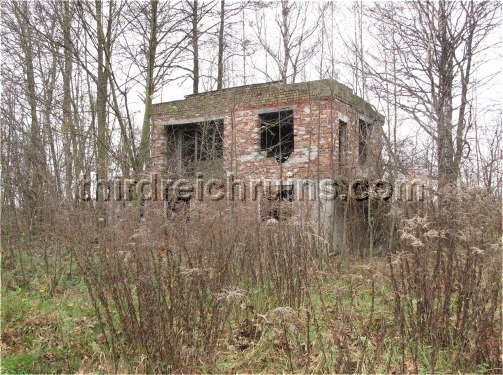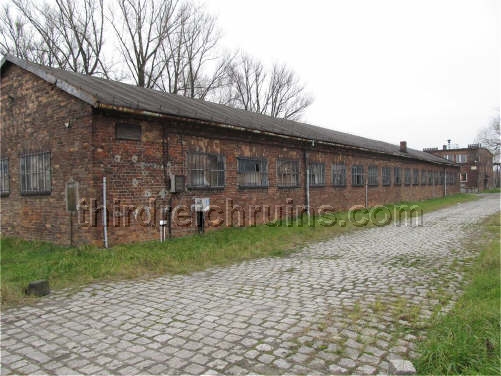|
Auschwitz-Birkenau -
Monowitz Camp and Buna-Werke Factory Site
As the Auschwitz concentration camp evolved from its beginning, one of
its primary purposes became providing slave labor to German industrial and
armaments firms. In April 1941, the IG Farbenindustrie chemical concern began
construction in Auschwitz of a huge factory complex to manufacture synthetic rubber
and fuel (IG Farben was a corporation formed from several German chemical
companies). This factory area was to the east of the town of Auschwitz, some six
kilometers from the Auschwitz I main camp, and was called the
"Buna-Werke" ("Buna" being an abbreviation for the
components used to manufacture synthetic
rubber), or "IG-Auschwitz." The site provided a large level area with ample
water and nearby coal and other raw material supplies, served by an adjacent
railroad.
Prisoner labor from Auschwitz was used to build the factory complex. At
first, prisoners from the Auschwitz I main camp were marched the six kilometers
to the Buna-Werke site, but this wasted too much time so they were moved to the
site by rail. As demand for prisoner labor increased, work camps were started
around the factory complex, and the prisoners were marched across the road and
into the factory site. The main camp was built in October 1942 at the southeast edge of the
factory area, and was called "Dorfrand" and later the "Buna
Lager." This became the largest camp and in 1944 it gained autonomy and
operated as Auschwitz III "Monowitz" (the Monowice village had been
located across the road from the camp), in charge of all the other Auschwitz
sub-camps (some 47 in total).
Prisoner labor at the Monowitz sub-camps was eventually provided by
selections from arriving train shipments of Jews from around Europe, numbering
over 35,000 prisoners in 1944 (the highest number in the Monowitz camp itself
was about 11,000). Mortality was high, as the work was strenuous and
living conditions poor.
The Buna-Werke factory site was bombed by the Allies on four occasions,
August-December 1944, doing considerable damage to some of the factory
buildings. Although some products such as synthetic fuel and oil were produced
in small quantities, the war ended before the primary product of synthetic
rubber ever went into production. Factory work ceased in mid-January 1945, and the factory site was
overrun and the remaining prisoners in the labor camps liberated by the Soviet
Army on 27 January 1945.
The primary workers
camps established for the IG Farben Buna-Werke factory complex were numbered and
designated as follows (some of these were labor camps for prisoners, and others
were simply barracks camp living areas for IG Farben civilian workers from
Germany):
Lager I - Leonhard Haag (civilian workers, mostly Germans, but also Italians and
later Italian POWs)
Lager II - Buchenwald (forced laborers from Poland, the Ukraine, and Russia)
Lager III - Teichgrund (German and Polish civilian workers, plus forced laborers
from the Soviet Union)
Lager IV - Dorfrand (this became the "Buna" camp, and later the
primary "Monowitz" camp, in charge of all the others; Jewish
concentration camp prisoners)
Lager V - Tannenwald (German and Polish civilian workers, plus forced laborers
from Croatia and the Soviet Union)
Lager VI - Pulverturm (German civilian workers, plus a separate section for
British POWs, designated Lager E715)
Lager VII - Angestellten Wohnlager (German civilian workers)
Lager VIII - Karpfenteich (British POWs, replaced by German civilian workers)
Lager IX (unnamed)
Lager X (unnamed)
Jugendwohnlager - also called the Lehrlingsheim (camp for German and Silesian
boys in training as IG Farben apprentices)
Jugendwohnheim-Ost - adjacent to the Jugendwohnlager (this camp housed girls
from the Bund Deutscher Mädel (BDM) and Kriegshilfsdient-Maiden of the RAD)
The
building designations in parentheses in the text (e.g., BW73) were the original
construction project numbers for each building.
|

|

|
|
Few period photos exist of the
Monowitz labor camp site. Above - a prisoner work detail marches out of the camp
toward the Buna-Werke factory, with the buildings of the Monowitz SS
Kaserne in the background. In the foreground is a one-man shelter for
the SS guard force, at the base of a guard tower. These shelters were
scattered around the perimeter of the work camps, for air raid
protection. The buildings of the
SS Kaserne that appear in the background of the period photo no longer
exist. Postwar buildings cover the Monowitz camp site today. Below, SS leader Heinrich Himmler visits
the Monowitz camp and Buna-Werke factory in July 1942. This was
Himmler's second visit to Auschwitz, and on this occasion he visited all
the camp and outlying facilities, and even observed a transport of Jews
being killed in the gas chamber of Bunker I at
Birkenau. (above
left
- U.S. Holocaust Memorial Museum; below - Bundesarchiv) |
 |
 |
|

|

|
|
Despite the fact that tour
guides and publications at the Auschwitz-Birkenau Museum (and, indeed,
most publications about Auschwitz) state there are
no remains of the Monowitz camp, various period buildings and ruins can
still be found there. The ruined brick building above was part of the SS
Barracks, adjacent to the prisoner camp enclosure. The building on the
left below is
said to be the original smithy building inside the prisoner compound,
and that on the right is said to be part of the original prisoners
kitchen (both structures are on the same spots as the original
buildings).
(Google
Maps link) |
 |
 |
|

|
|
Most of the visible remains at
Monowitz and the other Buna-Werke camps are air raid shelters. Several
concrete one-man shelters of the type shown above (at Monowitz) can be
found around the area. The concrete block in front of the door was meant
to stop bomb shrapnel from entering the door. The shelter below appears
to be an enlargement of one of the semi-circular shelter types seen at the top
of this page, into an underground shelter for several men. The barn/shed
buildings in the background of these photos are similar to
several buildings seen around the Monowitz site today, said to be built
from remains of the prisoner barracks and other period camp buildings.
(Google
Maps link) |
 |
 |
|

|

|
|
This large air raid bunker is
located to the south of the Monowitz camp, near the SS Kaserne. It is of
the type called "Salzgitter" or "Geilenberg"
bunkers, built extensively in 1944 around chemical and fuel production
facilities (see the similar bunker outside the Buna-Werke factory, below).
Curiously, there is one of the small semi-circular shelters just outside, seen in
the photo on the left above. Perhaps this shelter was already in place
before the large bunker was built. (Google
Maps link) |
 |
|

|

|
|
The bunker has entrances at each
end, covered by concrete walls both inside and outside the entry doors,
to guard from bomb shrapnel and blast going straight into the door
opening. The entry doorways originally had metal bunker closure doors. |
 |
 |
|

|

|
|
Various remains of the other
labor camps can be seen in the area. The building ruin on the left above
is in the site of Lager III Teichgrund. The ruin on the right above was
a water treatment facility near Lager VI Pulverturm. Nearby is the
artifact seen on the left below, sometimes called a water tower (perhaps,
since the adjacent camp was called "Pulverturm," this was some
sort of powder tower). The
photo on the right below shows this tower in the background, with one of
the semi-circular air raid shelters in the foreground. Note
- This tower was removed in the summer of 2015.
(Google
Maps link) |
 |
 |
Buna-Werke Factory Site
|

|

|
|
Although several have been
removed since 1945, some of the original wartime cooling towers are
still in place. The building in the left background of the period photo
is the power plant facility, which still exists. (Bundesarchiv) |
|

|

|
|
These original buildings from
the Buna-Werke remain at the factory site today, some still in use. |
 |
 |
-
|

|

|
|
Air raid shelters were also
provided around the periphery of the Buna-Werke factory site, for
civilian employees and workers. The large shelter above, of the
"Salzgitter/Geilenberg" type, the same as the shelter near the Monowitz camp but larger, is just outside
the northwest corner of the factory complex, near the site of Leonhard
Haag Lager I labor camp. (Note - This
bunker was demolished in 2016.) The smaller shelter below, similar to others
found on the factory grounds and in the Bereitschaftssiedlung
housing complex, is near the site of the factory fire department
headquarters. (Google Maps links - above,
below) |
 |
 |
|

|

|
|
An agricultural complex called
the Gutshof (BW73), just north of the Buna-Werke factory, was taken over by the
SS and used to provide foodstuffs, primarily meat products, for the
civilian factory workers. (Google Maps link) |
-
|

|

|
|
The IG Farben company provided a
large new housing area for its German employees, called the Bereitschaftssiedlung,
between
the Buna-Werke factory and the town of Oświęcim
(Auschwitz). This housing district provided apartments for 6,000 civilian workers, and is still in use today by the current factory
employees. Both photos were taken on Mariana Smoluchowskiego street. (Bundesarchiv
146-2007-0054) (Google Maps link) |
|

|

|
|
Two monuments at the Buna-Werke
and Monowitz sites honor the memory of those prisoners who labored and
died there. The monument on the left is just to the west of the IG
Farben factory site. The smaller memorial on the right is inside the
site of the Monowitz camp. (Google Maps - Buna-Werke
memorial; Monowitz
memorial) |

These relics of one of the Auschwitz
sub-camps exist in storage at the Auschwitz-Birkenau Museum.
They are two concrete statues of miners, by Polish prisoner Jakub Markiel, which
originally
flanked the entry to the sub-camp at the Jawischowitz coal mine. (Ref
5, pages 115-16)
 Continue to Auschwitz II Birkenau extermination
camp and concentration / slave labor
camp
Continue to Auschwitz II Birkenau extermination
camp and concentration / slave labor
camp
 Continue to
Auschwitz
"Interest Zone" - SS administrative buildings and
housing, and factory, agricultural, and support sites outside the main camps Continue to
Auschwitz
"Interest Zone" - SS administrative buildings and
housing, and factory, agricultural, and support sites outside the main camps
 Continue to
Judenrampe rail arrival site Continue to
Judenrampe rail arrival site
 Back to Auschwitz
main page Back to Auschwitz
main page
Official Auschwitz-Birkenau Museum Webpage --
http://en.auschwitz.org/m/
Follow these links to visit other Third
Reich in Ruins pages on concentration camp sites
-- Dachau, Buchenwald, Sachsenhausen,
Nordhausen (Dora), Flossenbürg,
S/III Jonastal, Mauthausen
(includes Gusen), Ebensee (Austria).
 Back to the Third Reich in Ruins homepage
Back to the Third Reich in Ruins homepage
|
